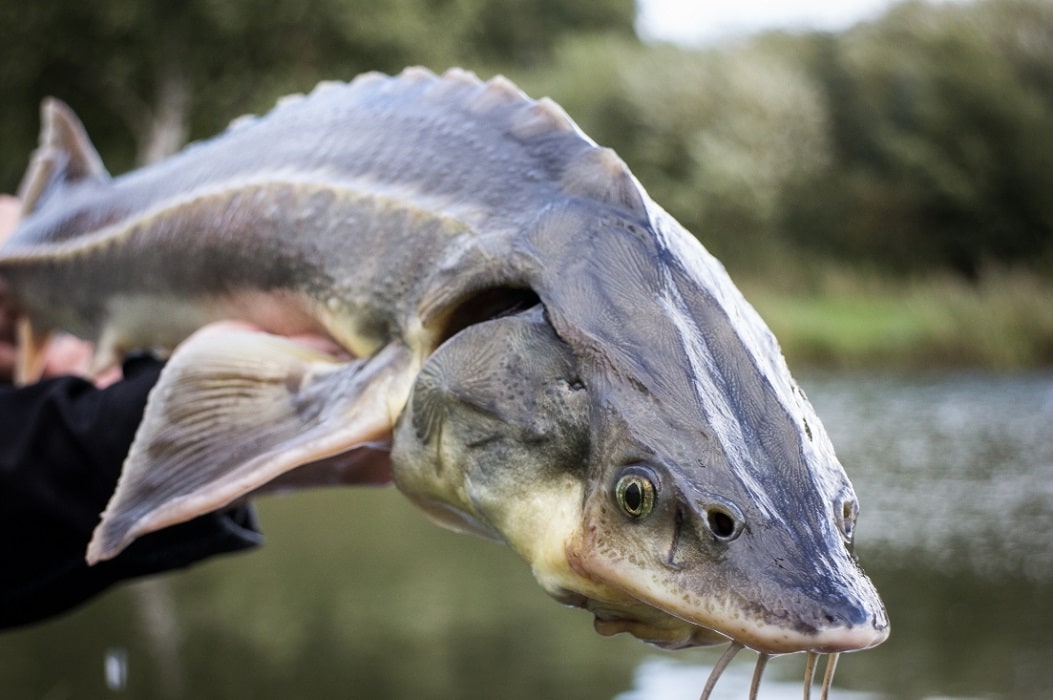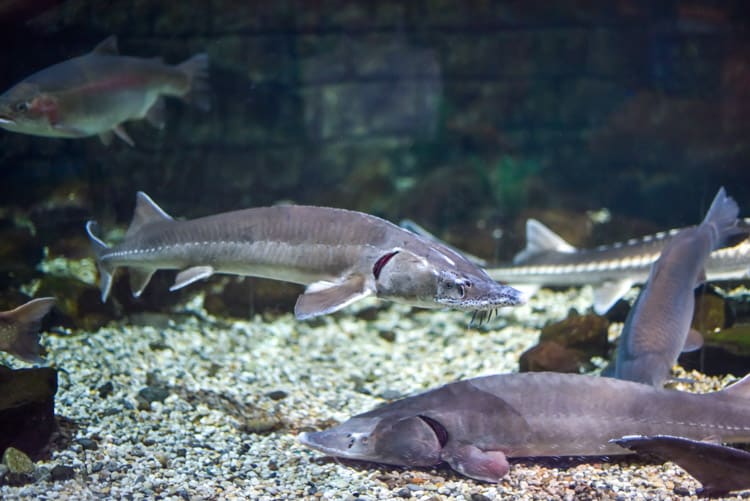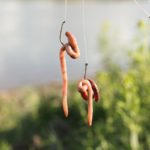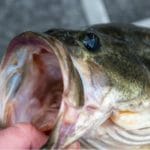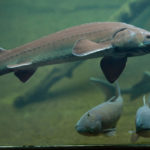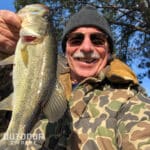Covered in armor-plating and spiked scales to deter predators, it’s surprising to me that sturgeon do not have teeth. Sturgeon are bottom filter feeders, much like common carp or suckers. Their barbels “taste” the water for anything from crayfish to mussels and they will take prey dead or alive.
Living in Minnesota provides me ample opportunities to chase these freshwater dinosaurs. The Mississippi and St. Croix Rivers offer both lake and shovelnose sturgeon.
Fishing for sturgeon is a combination of knowing their local waters and seasons as well as their main food source. Obtaining fresh and smelly bait is crucial for attracting these active predators, whether you find it or catch it yourself. Lastly, using bottom rigs can help keep your bait in the feeding zone and increase your chances of catching a sturgeon.
Follow me into this article, where we’ll do a deep dive into fishing for sturgeon. Read on to find out how to find, rig, hook, and land the elusive and incredible sturgeon.
How Do You Fish for Sturgeon?
Sturgeon fishing is a set-up, bait-your-hook, cast, and wait kind of activity.
While sturgeon are sometimes caught on flies or lures, this is very rare and not a practical method of fishing for these species.
How to Fish for Sturgeon from the Bank
If you’re fishing from the bank, grab a chair and a heavy-duty rod holder. While sturgeon strikes won’t suddenly yank a rod into the water, their sheer size makes losing a rod possible.
If you have your bait, you’ve rigged a slip sinker rig, and found an excellent sturgeon area, cast your rig across or slightly downstream in a river. Reel in the line so there’s no slack and set the rod in the rod holder.
Slackline while bait fishing results in missed strikes or swallowed hooks. Taught line tension ensures that we see every strike, bite, or nibble on the rod tip.
When fishing in lakes, simply cast as far out as possible and set up as before.
FUN FACT: Minnesota anglers on the St. Croix River will ice fish for sturgeon. They sleep overnight on the ice with rattle reels that go off when a freshwater dinosaur takes the bait.
How to Fish for Sturgeon from a Boat
When boat fishing for sturgeon, one technique prevails wherever you fish.
Using the same rigs, baits, and setups we’ve discussed before, use a topo map to find holes in the river and motor just upstream of the head of the hole. Ideally, you want to anchor the boat and cast your baits downstream, so they sit just around the lip of the hole.
This technique is very effective.
Some days the sturgeon will hug the middle of the pool or bowl. On other days they will sit just outside of it. If you don’t get a bite after awhile, re-cast until you find the sweet spot. Sometimes the difference can be mere feet.
A note about sturgeon fishing with bait: Since sturgeon “taste” the water with their barbels, allowing the baits to sit for long periods helps spread the scent in the area and allows the sturgeon to find it. There may be sturgeon that follow the scent trail from downstream.
How can you tell if a sturgeon is biting?
A sturgeon bite can resemble tapping, a steady pull, a deep throb, or a steady pumping cadence on the rod tip. Every sturgeon and every bite window is different. A sturgeon strike will also change depending on the current, the size of the sturgeon, and how heavy of tackle you are using.
A guide friend of mine always says, “If you’re not sure, remember, hooksets are free.” If you think you might be getting a strike, set the hook and reel in. Even if you swing and miss, you can always re-cast.
It’s also important to know that sturgeon baits are food items that many species like. If you constantly get small strikes but the fish don’t take the bait, chances are smaller species are just nibbling your bait.
How do you set the hook on a sturgeon?
Hooksets with J-Hooks
When using traditional J-hooks, set the hook on a sturgeon the same way you would any other species.
If you see the bite, gently grab the rod and hold it steady. At the next strike, you will jerk the rod sharply away from the fish in a quick snapping motion. If you move gently and sweep the rod, the fish might feel the hook and spit it out. A sharp motion is the best way to ensure a steady connection.
Hooksets with Circle Hooks
When using circle hooks, the hook set is very different. You don’t “set” the hook at all. Circle hooks are designed to sit in the corner of a fish’s mouth through line tension.
If you try setting a circle hook like a j-hook, you risk pulling the pin out of the fish’s mouth.
Instead, when you feel a strike, reel the line in with a steady retrieve, and the rod will load with the weight of the fish. As you fight the fish, the line tension will seat the hook deeper and deeper.
Circle hooks are preferable to J-hooks when fishing for sturgeon for three reasons:
- Sturgeon mouths are angled down and are rounded compared to other fish. Circle hooks tend to sit in their mouths better.
- Circle hooks reduce the chances of a sturgeon swallowing the bait.
- Circle hooks are easier to remove, especially when fished without a barb. Since barbless hooks rely on line tension to keep the hook in the fish’s mouth, barbless circle hooks are the perfect combination of low injury, low risk, and high hooking percentage.
Do sturgeon fight hard?
Sturgeon can grow to over 1000 pounds. For folks using light tackle, fighting a trophy-sized sturgeon can take upwards of 45 minutes to an hour.
Even for seasoned sturgeon anglers with heavy tackle, the fight can last a half hour, with the tug-o-war battle leaving your arms shaking from adrenaline and fatigue.
That said, even smaller sturgeon around 18 inches or more fight hard and stick to fast currents. Sturgeon are known to jump out of the water, bulldog to the bottom, and zig-zag as they try to get off the hook. You never know what you might get!
As with all large fish, make sure your drag is set correctly and learn how to fight large fish before striking out for a trophy sturgeon.
A good rule of thumb for fighting big fish is, “When they want to run, let ‘em run. When they heel, go ahead and reel.” This mantra has saved me more than a few times when my excitement got the best of me and I was almost too aggressive fighting a big fish.
Sturgeon Fishing Seasons and Rules
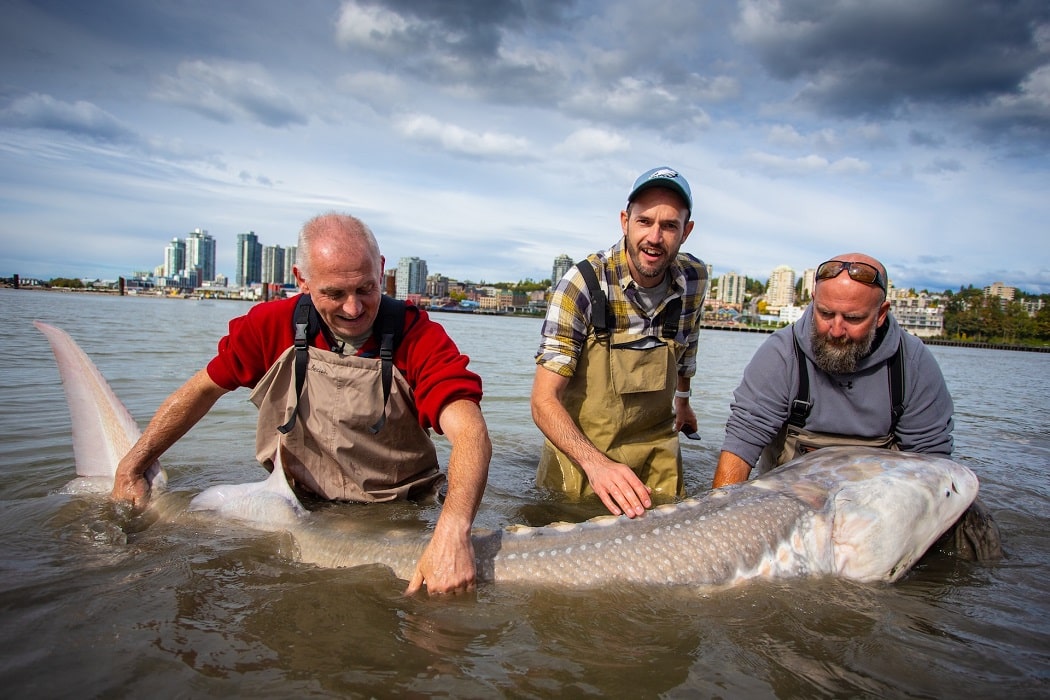
Sturgeon fishing seasons are strictly enforced and vary depending on certain stretches of the same river, seasonal changes, and differences in state agencies. It’s essential to check and re-check local sturgeon regulations before fishing for sturgeon, especially if you plan to keep one.
Just like hunting, sturgeon seasons are sometimes managed by tags.
These regulations ensure sturgeon populations are managed effectively, and the species are maintained for future generations to enjoy.
If catch-and-release angling, keeping the sturgeon in the water is best to protect its slime coat. Avoid setting it on the ground, gravel, sand, or concrete. A fish’s slime coat acts as its immune system. The fish is susceptible to disease if that surface covering is wiped away.
Terminology and Common Rules
The rules for first-time sturgeon anglers can feel complicated. Here are 6 words and phrases every beginner sturgeon angler should know.
- Catch and release: Catch and release angling refers to catching fish, handling them as minimally as possible, and releasing them back into the water.
- Keep/Catch and Cook: Catch and cook or keep anglers most often keep a fish or multiple fish for food, to have it mounted, or to have it weighed as part of angling record collections.
- Low-impact angling: Low-impact angling aims to leave as little behind as possible. This includes trash, injured fish, and signs of angler activity like forked stick rod holders.
- Barbless hooks: Barbless hooks are specialty hooks made without a barb. Barbless hooks significantly reduce injury to the fish and make hook removal much faster.
Note: Some people say that barbless hooks lose too many fish. The key to reeling in fish with a barbless hook is to maintain tension on the line. If you allow slack in the line, the hook may pull free. Maintaining tension always ensures a straight line between you, the fish, and the fish’s mouth. - Non-remove from water: Non-remove from water rules require an angler to keep the fish in the water for the entire time they interact with it. From landing, hook removing, picture taking, and releasing, sturgeon anglers fishing on waters with non-remove rules should never lift a sturgeon out of the water.
Depending on the season, some sturgeon anglers will wade into the water to gently cradle the sturgeon before releasing it. This is the law in Idaho and other states, so be sure and check the regs where you’re fishing. - Handling sturgeon: Safe handling of sturgeon includes using non-abrasive rubber nets when landing them, always using a soft material or wet hands to hold them, and using proper hook removal technique to reduce injuries around their mouths.
Rig Requirements
The sliding sinker set-up for Idaho sturgeon fishing is one example of a rig requirement in place to reduce accidental injury to sturgeon populations.
The Idaho Fish and Game manual says that:
Research has found that baited hooks, fishing line, and swivels, broken off by anglers, may be ingested by sturgeon, and in rare instances cause death. Because of this, IDFG adopted rules designed to reduce the amount of tackle lost by anglers with the overarching goal of reducing unintentional sturgeon deaths.
As you can see, sturgeon fishing rules and regulations will change depending on where and when you are fishing. Always research beforehand and talk to your local fisheries management organizations if you have questions.
These actions will ensure viable sturgeon populations–and opportunities to fish for them–for years to come.
Where to Find Sturgeon
Sturgeon habitat is a mix of gravelly, rocky bottoms and those areas adjacent to muddy flats. This combination of resources offers the most food for hunting sturgeon.
On the gravelly, rocky bottoms, sturgeon can find crayfish, small minnows, aquatic insects like hellgrammites and dobsonfly larvae, and decaying materials that get caught between the cracks.
On the muddy flats, sturgeon roam looking for clams and other stationary food items.
That said, sturgeon are always on the move and constantly “taste” the water, sucking up food items they pass.
Sturgeon seek out the deepest holes and often sit around them. This is where low-pressure zones collect food.
Professional and amateur sturgeon anglers protect good sturgeon holes because they know that sturgeon will return to these places year after year.
Good sturgeon habitat also offers deep, cold regions of riverways. While ocean-run sturgeon run upriver to spawn, most of their time is spent in the ocean. Similarly, freshwater sturgeon populations need areas of cold, deeper waters to thrive and migrate to spawn.
United States Sturgeon Fishing Hot Spots
There are a surprising amount of sturgeon fishing spots in the US. In fact, catchable populations of sturgeon exist all across the US. But if you want the chance at a world-class sturgeon, these are your destinations.
The Great Lakes Region: Rainy River
The Rainy River on the border of Minnesota and Canada is a fantastic sturgeon fishery. The fish here are densely populated, and it’s not uncommon to catch multiple fish in a day.
The Pacific Northwest: Columbia River
The Columbia River is home to some true giant sturgeon. Some of these fish can live to be 150 years old and take an hour or more to reel in due to their strength and size.
The West Coast: Willamette River
The Willamette River is a popular sturgeon fishery known for large fish and impressive numbers. These fish spawn in the rivers and live in the ocean migrating back and forth as their seasons develop.
The West: Snake River
The Snake River in Idaho holds some impressive opportunities for the adventurous angler. The Hell’s Canyon section of the river is within a wilderness access area. This means the waters are unpressured, the sturgeon are giant, and the views surrounding an angler are impressive.
Famous sturgeon water: The Fraser River
The Fraser River is where our expert guide, Marc Laynes, spends much of his time guiding clients.
His guiding company’s site says, “If you are worried about hooking that thousand-pounder, rest easy – most of the “larger” fish average between 100 and 300 pounds! However, our largest sturgeon was just shy of 900 pounds and measured 11 foot 3 inches from tip to the fork of the tail!”
The Fraser River is a famous sturgeon fishery above Seattle, Washington in Canada.
How deep do you fish for sturgeon?
When fishing for sturgeon, you should always be fishing on the bottom, no matter how deep the water is. Sturgeon feed on the bottom of the water column. It’s always a good idea to research the specific waters you plan to fish and talk to local experts for guidance on the best depth to target sturgeon in that area.
What time of day is best to fish sturgeon?
Generally, sturgeon, like most fish species, are most active in the early morning and late evening with an inactive period in the middle of the day. This may change depending on local conditions, water temperature, sunlight, and water depth.
However, seasoned sturgeon anglers know that night fishing for sturgeon is the best angling time of day. Sturgeons cover more water at night and are willing to swim in shallower areas. This makes night fishing the best option for anglers fishing from shore.
Sturgeon Fishing Setup
When fishing for sturgeon, focus on heavy, strong lines with a sinker slide bottom fishing system or a slip sinker rig in states that allow it. This ensures that our bait is always in the feeding zone.
For terminal tackle, at minimum, you will need a combination of the following:
- Weights heavy enough to stay on the bottom
- Popular weights include no-roll, pyramid, and egg sinkers
- Octopus hooks or circle hooks in sizes 8 up to 3/0 to 5/0, depending on the size of sturgeon in your area
- Barrel Swivels
- Beads
- Fluorocarbon leaders (30 to 50 pounds is common, for smaller fish 10 ponds is enough)
- Sinker slides (if using pyramid sinkers or a sinker slide rig)
- Lightweight dropper line for the sinker slide rig
Sturgeon Fishing Gear
Anglers of all species have go-to items. Sturgeon anglers are no different. Generally, sturgeon are hard-fighting fish that can grow to behemoth sizes.
When sturgeon fishing, consider the average size in your area and plan accordingly.
It’s a good idea to use heavier lines and gear than you think you need for two reasons:
- Even if the average sturgeon size is comparatively small for sturgeon waters, the larger sturgeon will feed in the same area. These fish are not territorial.
- Sturgeon have no teeth, but the sharp spines on their backs, sides, and gill plates can cut through line. Having a thicker line ensures that it will hold up to any sharp or abrasive surfaces.
Rod, reel, and line setups for sturgeon fishing are similar to sets made for catfishing, muskie fishing, carp fishing, and surf fishing in the ocean. Catfish anglers are known to catch sturgeon as by-catch because they use smelly baits that sit on the bottom.
Sturgeon Fishing Rigs
The tried and true rigs of sturgeon anglers everywhere are bait rigs that will hold bait on the bottom. We must stay in the sturgeon’s feeding zone to entice a bite.
Here are a few of the most popular rigs for fishing for sturgeon.
Slip Sinker Rig
When people talk about a “sturgeon rig,” they refer to any variation of a slip sinker rig with a snelled hook.
Snelled hooks are hooks with a pre-tied leader attached to a swivel. The benefits of snelled hooks are ease of re-rigging and ease of selecting leaders, hooks, and bead colors depending on conditions.
You can make snelled hooks at home or purchase them online.
You can use sinkers directly on the line like a no roll or egg sinker, or use a sinker slide system paired with a pyramid sinker, slinky sinker, or any other of your favorite styles.
The sinker should be heavy enough not to move with the current.
The slip sinker rig does three things:
- Keeps our bait on the bottom.
- Provides the most feel and strike sensitivity since the weight is not attached to the line. Since these rigs allow the line to slide freely through the weight or slide, the sinker does not introduce drag and is very effective for light bites.
- Makes sturgeon fishing accessible for anyone without needing specialty rigs.
Sinker Slide Rig with a Dropper
Idaho Fish and Game requires a sliding sinker rig with a breakaway system for the weight. The idea is if the weight becomes snagged, the lighter line between the weight and the main line will break, allowing the baited hook to be reeled back in.
Three-Way Breakaway Rig
The three-way breakaway rig is another option for sturgeon anglers. This rig uses a three-way swivel. One loop goes to the rod, one loop attaches to the leader and hook, and the third loop connects the weight with a short length of dropper line.
This rig has no slip component, but some anglers prefer having weights fixed to their line.
Sturgeon Fishing Baits
If you imagine a sturgeon as a giant, armor-plated catfish, then you’d be on your way to understanding sturgeon baits with one exception: sturgeon love fresh bait—the fresher the bait, the better.
In sturgeon fishing waters nationwide, a tried-and-true bait is a gob of worms on a circle hook. The larger the mess of worms on the end of your line, the better the chances of hooking into a monster sturgeon. The writhing mass of worms is smelly, has a lot of activity underwater, and is a large, nutritious offering.
We did a super deep dive and interviewed an expert guide in this article covering the Best Bait for Sturgeon. Hit the link for the best sturgeon baits and bait tips around.

